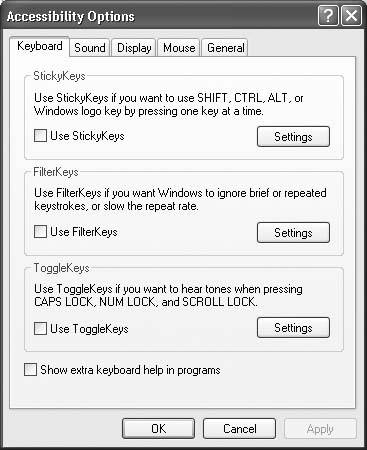10.2. Accessibility Options Most of the options here are designed to make computing easier for people with disabilities , though some options can benefit almost anyone (Figure 10-2). Figure 10-2. Double-click the Accessibility Options icon in the Control Panel to open the dialog box shown here. You start out looking at the Keyboard tab, which offers useful ways to adjust keyboard behavior. Clicking any of the Settings buttons allows you to fine-tune many of these features, making it even easier to accommodate special computing needs. 
In addition to what's listed on this panel, one of the simplest and most powerful aids to people with failing vision is the "Windows Standard (large)" and "Windows Standard (extra large)" Desktop Themes. You'll find these controls in the Display program's Appearance tab, as described later in this chapter (Section 10.10). With a single click, you can make Windows enlarge the font used in all of its dialog boxes, menus , icon names , tooltips, and so on. Don't miss the Mouse program (Section 10.16), either, where you can select much larger arrow cursors . -
Keyboard Tab . Three keyboard adjustments make it easier for some people to type without errors. StickyKeys is for people who have difficulty pressing two keys (such as Ctrl, Alt, and Shift key combinations) at once; it allows you to press the keys of a keyboard shortcut one at a time. With FilterKeys turned on, Windows XP treats a key that is held down as a single keystroke, instead of producing a string of letters like thisssssssss . Finally, when you turn on Toggle-Keys , the computer beeps whenever you press the CapsLock, NumLock, or ScrollLock key. -
Sound Tab . Turning on SoundSentry instructs Windows XP to make your screen flash or blink when a sound occursa useful feature if you have trouble hearing. Turn on ShowSounds if you'd like your applications to display an explanatory caption every time a sound is generated. (Not all programs do, although those specifically advertised as being Windows XPcompatible generally do.) -
Display Tab . Here, you can choose Use High Contrast to make text easier to read. You can also make the blinking insertion point fatter, or make it blink faster. -
The Mouse Tab lets you use the number keypad to control the arrow cursor. -
The General Tab lets you set Windows XP to turn off accessibility options if it's been awhile since you've used them. This setup is also useful when several people share the same PC on the same account (see Chapter 12), and only one of them requires these options. |
